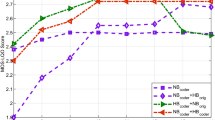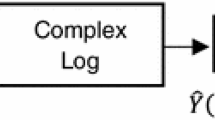Abstract
Vocoders are designed/used to reduce the bit rate requirement for speech signal transmission without significant degradation in the quality of the resultant speech. In most of the speech coding techniques, the system and the source parameters are coded separately. The system is generally coded using a codebook which demands only less number of bits compared to source coding. Coding of the source parameters requires significant computational complexity and memory to preserve the identity and naturalness of the speaker. In this work, a LPC vocoder is designed which uses the instants of significant excitation estimated from the speech signal to code the source information. Traditional pitch excited LPC vocoders produce intelligible speech at a bit rate of 2400 bps, but they are often synthetic. Hence source is coded by identifying the locations of instants of significant excitation and the corresponding strength at those instants. Thus the bit rate requirement is reduced significantly in the order of 1.6Kbps when a code book of size 1024 is used. The number of bits used for coding the system is further reduced by using the codebook of reduced size, namely 64. But the quality of resynthesized signal decreases as the poles representing the system are defocused due to high averaging. Hence, pole focusing, increasing the radius of the poles is done. This causes the increment in the gain/magnitude of the corresponding frequency component in the spectrum thereby improving the signal quality. Finally, the bit rate requirement is further reduced in the order of 1.3kbps. The performance analysis shows that the resultant synthesized speech is intelligible and quite natural preserving the identity of the speaker.
Access this chapter
Tax calculation will be finalised at checkout
Purchases are for personal use only
Preview
Unable to display preview. Download preview PDF.
Similar content being viewed by others
References
Gold, B., Morgan, N.: Speech and Audio Signal Processing: Processing and Perception of Speech and Music. John Wiley & Sons, Inc., New York (1999)
Gold, B., Rader, C.M.: The Channel Vocoder. IEEE Transactions on Audio and Electro Acoustics AU-15(4) (December 1967)
Davie, M.C.: Channel vocoder based on c.c.d. discrete-fourier transform Processors. IEEE Proc. 127, pt. F(2) (April 1980)
Martins, J.A., Violaro, F.: Low bit rate LPC vocoders using vector quantization and interpolation, pp. 597–600. IEEE, Los Alamitos (1991)
David, E.E., Schroeder, M.R., Logan, B.F., Prestigiacoma, A.J.: Voice-excited vocoders for practical speech bandwidth reduction. Presented at the Speech Communication Seminar, Stockholm (1963)
Magil, D.T., Un, C.K.: Residual-excited linear predictive coder. JASA 55, Suplement abstract NN3 in the April 24-26 87th meeting of the Acoustical Society, 581
Weinstein, C.J.: A linear prediction vocoder with voice excitation. In: Proc. Eascon 1975, Washington, D.C, pp. 30A-30G (1975)
Schroeder, M., Atal, B.: Code-excited linear prediction: high-quality speech coding at very low bit rates. In: Proc. ICASSP 1985, Tampa, pp. 937–940 (1985)
Ubale, A., Gersho, A.: A multi-band CELP wideband speech coder. In: IEEE Proc. ICASSP 1997, pp. 1367–1370 (April 1997)
McCree, A.V., Barnwell, T.P.: A Mixed Excitation LPC Vocoder Model for Low Bit Rate Speech Coding. IEEE Transactions on Speech and Audio Processing 3, 4 (1995)
McCkllan, S.A., Gibson, J.D.: Variable Rate CELP Based On Subband Flatness. IEEE Transactions on Speech and Audio Processing 5(2) (March 1997)
Park, Y., Yang, J., Sohn, S., Bae, M.: On a time reduction of pitch searching by the regular pulse search technique in the CELP vocoder. IEEE, Los Alamitos (1997)
Sripriya, N., Vijayalakshmi, P., Arun Kumar, C., Nagarajan, T.: Estimation of Instants of Significant Excitation from Speech Signal using Temporal Phase Periodicity. In: IEEE TENCON 2009 (2009)
Yang, G., Leich, H.: A Robust and Fast DP-CELP (Double-Pulse CELP) Vocoder at the Bit Rate of 4 kbh. In: International Symposium on Speech, Image Processing and Neural Networks (April 13-16, 1994)
Rabiner, L., Juang, B.-H., Yegnanarayana, B.: Fundamentals of Speech Recognition. Pearson Education, London (1993)
Wei, B., Gibson, J.D.: Comparison of distance measures in discrete spectral modeling. In: Proc. 9th DSP Workshop & 1st Signal Processing Education Workshop (2000)
Rabiner, L.R., Schafer, R.W.: Digital Processing of Speech Signals. Prentice-Hall, Inc., Englewood Cliffs (1978)
Abraham, A., Vijayalakshmi, P., Nagarajan, T.: Pole-focused linear prediction-based spectrogram for coarticulation analysis. In: IEEE TechSym, pp. 94–97 (2010)
Author information
Authors and Affiliations
Editor information
Editors and Affiliations
Rights and permissions
Copyright information
© 2011 Springer-Verlag Berlin Heidelberg
About this paper
Cite this paper
Saranya, A., Sripriya, N. (2011). LPC VOCODER Using Instants of Significant Excitation and Pole Focusing. In: Nagamalai, D., Renault, E., Dhanuskodi, M. (eds) Advances in Parallel Distributed Computing. PDCTA 2011. Communications in Computer and Information Science, vol 203. Springer, Berlin, Heidelberg. https://doi.org/10.1007/978-3-642-24037-9_18
Download citation
DOI: https://doi.org/10.1007/978-3-642-24037-9_18
Publisher Name: Springer, Berlin, Heidelberg
Print ISBN: 978-3-642-24036-2
Online ISBN: 978-3-642-24037-9
eBook Packages: Computer ScienceComputer Science (R0)




